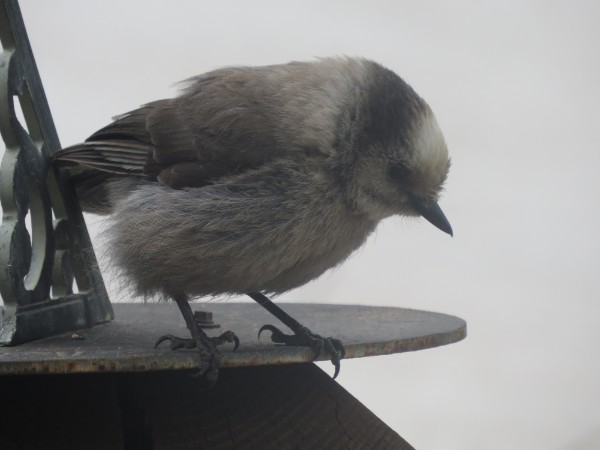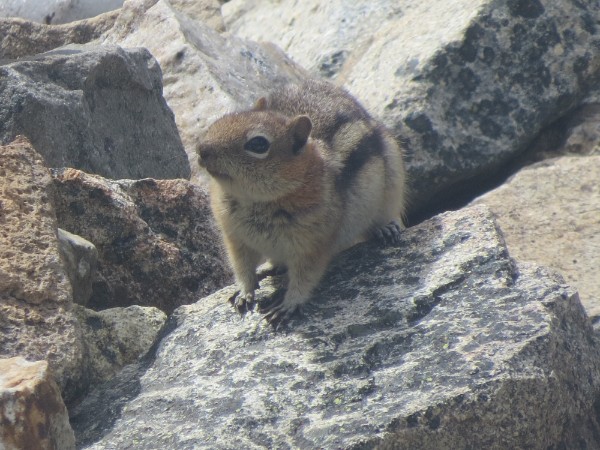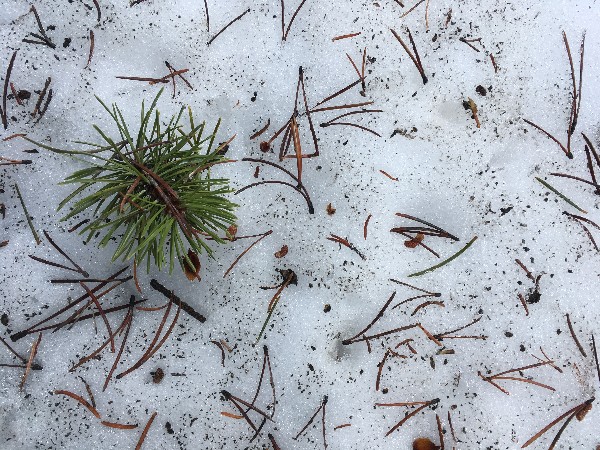new to the neighborhood
looking down at El Capitan Lodge from the slopes of Taylor Hill
new to the neighborhood
they peek out and test our scent
Goldie the ground squirrel
popping up from the rocks at the edge of the deck
the pair of pine grosbeaks
decorating the aspen before leaf-out
and the mountain chickadees
unabashedly evaluating a nest site
while I gawk five feet away
in mid-morning
violet-green swallows careen about the eaves
regardless of where we are
and any time we’re in the woods
the gray jays find us first
I try to strike up a conversation
introduce myself
but their eyes are on our palms
wondering whether we’re handout types
exactly 28 minutes after
hanging up the hummingbird feeder
I hear him pause midflight
I rush to the window
just in time to see him take a sip
seemingly not to his satisfaction
then he buzzes up a story
looks me in the face
as if to say
puh-lease!
we’ve seen deer tracks in the dirt
and woodrat scat in the shed
(beside the ripped-open recycling)
and this evening
a ball of sunset glow came trotting
down the hill to the east
lighting up the family room windows
jovial, unconcerned
we leapt up
and as if to put us in our place
the red fox squatted
marked her territory
and nonchalantly kept going down the road
we’re summer people, after all
unlikely to make friends
(despite our best efforts)
glad to settle for some
curious new acquaintances
Gray Jays and Mountains
Yesterday we went on a short hike up the road near our cabin, and we observed the first Gray Jays of the trip! These birds are very intelligent, familiar, and are actually the national bird of Canada! They are somewhat common at high elevations, and are also called Canada Jays and “camp robbers” because they have recognized campsites as sources of food and steal food from the occupants. Also during the day the clouds over the mountains parted and created apparent pools of light on the mountainsides. Here are the photos!









6 June 2019 Joke of the Day
highlight the black block to find the answer
Q: What’s green and has wheels?
A: Grass. (I lied about the wheels.)
eating apples
some things are hard to swallow
thirty years believing
nothing was going down
all that ending
in daily chitchat
about nonsense
my grandfather
after his stroke
begging for ice
me not knowing
which was compassion
giving in or denying him
immune tonic
so vile I shake
each time I take a swig
sitting there on the shelf
through my coughing spell
an open challenge
I’m not ready to meet
the orange pills
that let me run
and keep my sight
but claimed my gut instead
our sweet son
grimacing at an apple
refusing to obey
his need to please
oh as antidote
to all the bitter herbs
stored in my little chest
I’m gonna chew on pine needles
and Old Man’s Beard
swallow big draughts
of sun and snow
wash them all down
with muddy meltwater
and the strong tea of tannin
make my own tincture
of silence and time
wait for the healing to come
Birding and Errands (but mostly birding)
Yesterday we went on a short walk on the Mineral Belt Trail. The trail provided many opportunities for birding and provided excellent views of Mountain Bluebirds, Brown-headed Cowbirds, Pine Siskins, and many more. Additionally, the birds around the cabin were particularly active, such as Violet-green Swallows fighting for food, and Mountain Chickadees visiting a potential nest site right on the deck! Here are some of the highlights.















